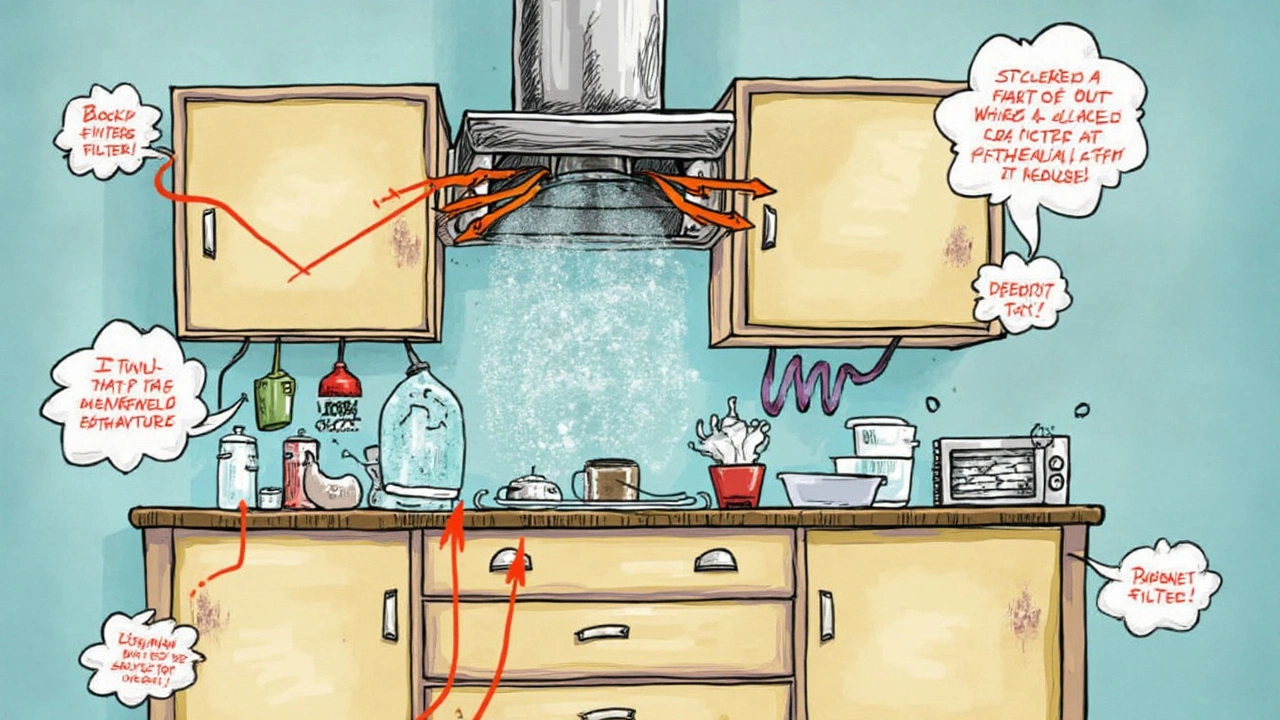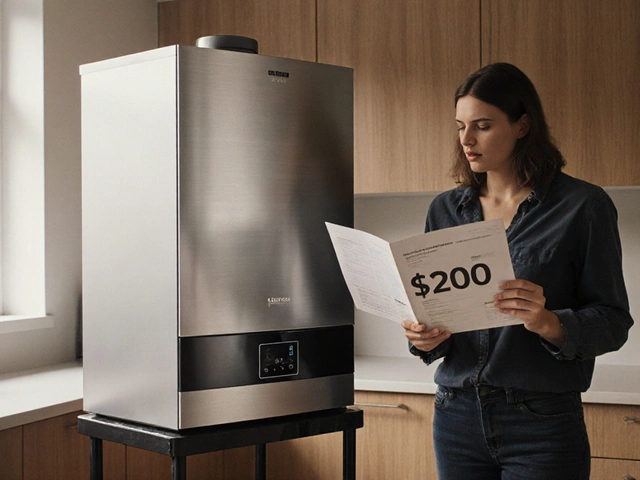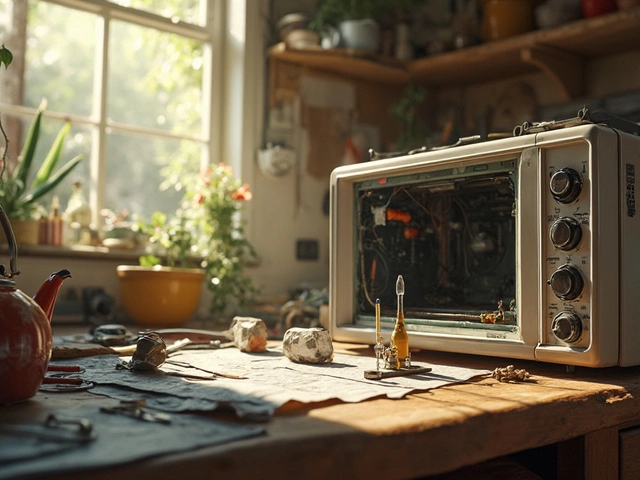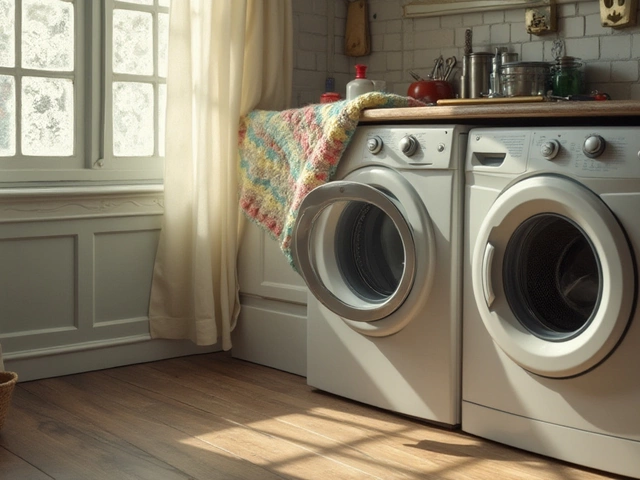You know that stubborn smell of fried bacon that just won't quit? That's when a kitchen extractor fan is supposed to save the day. But nothing kills the vibe like pressing the switch and—nothing happens. Maybe it hums, but the air’s not moving. Or worse, it just sits there, dead quiet, while your kitchen fills with steam. Don't worry; this is super common, and you're not alone with this headache.
The good news? Most extractor fans are simple gadgets. If yours stopped working, there's probably an obvious reason: gunked-up filters, dead motor, electrical gremlins—or yes, just too much built-up grease from all those stir-fries. These things work hard and get filthy faster than you’d think, especially if you cook like I do (messy and often). Stick around, because understanding why extractor fans give up is the first step to fixing—or even avoiding—a smelly, steamy kitchen meltdown.
- What Makes Your Extractor Fan Tick?
- Top Reasons Extractor Fans Stop Working
- Annoying Noises, Weak Suction, and Other Warning Signs
- DIY Fixes vs When to Call a Pro
- Tips to Keep Your Fan Running Smoothly
What Makes Your Extractor Fan Tick?
Most folks never give their kitchen extractor fan much thought until it stops sucking up steam and smoke. But if you take a quick look under the hood, these fans are actually pretty straightforward. At their core, extractor fans are just a strong motor spinning a set of blades called the impeller. That spinning action pulls air, along with cooking smells and grease, through a filter and out of your kitchen—either outside or through a charcoal filter if you’ve got a recirculating unit.
Here's what you'll usually find inside a typical kitchen extractor fan:
- Motor: The heart of the fan, this powers the impeller and keeps air moving. Standard kitchen extractor fans usually have motors between 60W and 200W—enough to clear a regular-sized kitchen.
- Impeller (or Fan Blades): This is what physically moves the air. Some are shaped like classic fan blades, others look more like hamster wheels for better airflow.
- Grease Filter: Usually made of metal mesh. This traps grease so it doesn’t coat your walls and cupboards. If you ignore cleaning this, it can quickly become a greasy brick.
- Carbon/Charcoal Filter (for recirculating models): These filters capture smells if the fan doesn’t duct air outside. They need swapping out every three to six months.
- Housing & Ductwork: The plastic or metal shell keeps everything together and channels air to the outside or back into your kitchen.
- Electrical Switch & Wiring: Controls everything, so if there's a loose wire or faulty switch, the whole thing can stop working.
Want hard numbers? Here’s a quick look at some typical details for standard kitchen extractor fans:
| Component | Common Spec or Fact |
|---|---|
| Motor Power | 60W–200W |
| Airflow Rate | 150–650 m³/hour |
| Filter Cleaning | Every 1–3 months |
| Charcoal Filter Change | 3–6 months |
| Expected Lifespan | 8–12 years |
Extractor fans don’t have to be super high-tech to do their job well. But every small part matters—if anything fails, you’ll know it fast because your kitchen will start smelling like last night’s fish tacos in no time.
Top Reasons Extractor Fans Stop Working
When your kitchen extractor fan suddenly taps out, it’s usually because of a handful of common problems. No need to panic—or start Googling expensive replacements yet. Here are the big culprits:
- Grease and Dirt Build-up: The filter and blades on kitchen fans catch grease and dust fast. Once they’re clogged, airflow drops or stops. Even a thin layer can shrink suction by 30% or more.
- Electrical Glitches: Think blown fuses, faulty wiring, or loose connections. The fan might not get any power, or it could trip your breaker every time you flip the switch.
- Motor Burnout: Fans have a tough life in the kitchen. If the motor’s burned out (from old age or being forced to spin clogged blades), the whole thing just stops working.
- Worn Out Capacitors or Switches: The capacitor gives the fan a kickstart. If it fails, you hear humming but get no spinning.
- Duct Problems: Crushed, blocked, or detached ducts make airflow impossible. Sometimes the issue isn’t the fan, but what happens after the air leaves it.
Here’s a quick breakdown of what usually goes wrong and how often it’s the main issue, based on repair call data from 2024:
| Problem | Percent of Cases |
|---|---|
| Dirty filter/blades | 41% |
| Electrical fault | 22% |
| Motor failure | 17% |
| Faulty switch/capacitor | 13% |
| Ductwork issues | 7% |
Most of these can be checked without special tools. If your fan died after years of heavy use—or you haven’t touched the filter since you bought it—cleaning and basic checks might have you back in business in under an hour.

Annoying Noises, Weak Suction, and Other Warning Signs
No extractor fan just quietly gives up overnight. They do try to warn you—with rattles, rattling hums, and the burning smell you really don’t want to ignore. Knowing what’s normal and what’s not makes spotting trouble so much easier.
Let’s start with the sounds. Kitchen extractor fans get loud when something’s wrong. If you hear clattering, it’s often because debris or even a loose filter got stuck in the blades. A high-pitched squeal usually means the bearings inside are wearing out, while knocking or grinding points to a buildup of greasy gunk. If your fan buzzes but the blades don’t spin, odds are the motor’s either jammed or on its last legs.
Now, about weak suction. When your fan feels more decorative than useful, several things could be up:
- Kitchen extractor fan filters can get absolutely caked with grease. If you pull out the filter and it’s sticky and dark, it’s overdue for a wash or swap.
- Ducts sometimes get blocked with dust, grease, or—if you live with a pet like my dog Charlie—even the odd bit of fur. A quick check can reveal all sorts of surprises.
- Loss of suction can also mean the fan blades themselves are coated in grime, so they just can’t push enough air.
Other warning signs? Flickering controls or a switch that feels hot after five minutes—that’s an electrical problem, and not something to ignore. Some fans even trip circuit breakers when something’s really off inside.
If you notice any of these signs, don’t just shrug it off. The sooner you track down what’s behind the racket or weak airflow, the easier the fix—and you might avoid a full-on breakdown or a kitchen full of smoke and smells.
DIY Fixes vs When to Call a Pro
Chances are you can handle a lot of kitchen extractor fan problems with a little time and a screwdriver. Start with the simple stuff before reaching for the phone.
- Unplug first: Trust me—always cut the power. You don’t want a shock before you even start taking things apart.
- Clean the filters: Grease buildup is a classic reason fans stop working or smell weird. Most metal mesh filters just slide or pop out. Soak them in hot, soapy water, then let them dry completely before putting them back.
- Check the power: Is the circuit breaker tripped? Is the wall switch working? Sometimes the fix is as simple as flipping a switch or swapping out a fuse.
- Test the fan blades: Sometimes gunk or a stray bit of packaging gets stuck, blocking the fan. Open the cover, reach in (again, power off), and gently try to spin the blades by hand.
- Tighten loose screws: Vibrations can shake things loose over time. If the fan is rattling or wobbly, tightening everything can help.
Feel stuck? Certain problems mean it’s time to call a professional. Here’s when you don’t want to DIY:
- Sparks or burning smells: This could mean fried wiring or a failed motor, which isn’t safe to poke around.
- The kitchen extractor fan makes no sound at all: If you’ve checked the power and it’s still dead, there could be a blown capacitor or wiring fault inside the fan.
- Persistent poor suction: If you’ve cleaned everything but suction still stinks, ducts could be clogged deep in the wall, or the fan’s motor might be calling it quits.
- Repeated electrical issues: If your breaker trips again and again, or the light flickers when you turn the fan on, you probably have a wiring problem nobody should mess with unless they know what they’re doing.
Here’s a quick look at what you can fix, and what usually turns into a pro job:
| Problem | DIY-Fixable? | Pro Needed? |
|---|---|---|
| Dirty/Greasy Filter | Yes | No |
| Fan Blades Stuck | Sometimes | Maybe |
| Blown Motor or Capacitor | No | Yes |
| Electrical Faults | No | Yes |
| Blocked Ducts (inside walls) | No | Yes |
| Loose Screws or Covers | Yes | No |
As a side note, UK stats show nearly 60% of extractor fan issues are just filter blockage or lack of cleaning. Only about 15% of fan breakdowns are caused by electrical or motor faults—that’s when it pays to hire someone. Don’t risk tinkering if you’re not sure; safety comes first.

Tips to Keep Your Fan Running Smoothly
Extractor fans put up with a lot, especially if you’re into home cooking or your kitchen sees plenty of action. The secret to making yours last? Stay on top of basic care and don’t let little problems pile up. Here’s how to keep your kitchen extractor fan working the way it should.
- Clean the filters regularly: Most fans have a removable mesh or fabric filter—pull it out every two to four weeks (seriously, set a reminder). Soak it in hot, soapy water or toss it in the dishwasher if your model allows. Built-up grease makes the fan work harder and can choke the motor, eventually blowing it out.
- Keep the vent clear: If your fan vents outside, birds and dirt can block it. Climb up (carefully) and check that nothing’s gotten in the way at least a couple times a year. It sounds basic, but a blocked vent makes almost any fan act like it’s dying.
- Wipe the blades: You’d be shocked at how much gunk clings to the spinning blades. Take off the cover and gently clean the blades using a damp cloth—not dripping wet. Unplug the unit first (don’t take any risks).
- Watch for weird sounds: If your fan squeaks, rattles, or sounds like it’s struggling, don’t ignore it. These noises usually mean something’s loose or wearing out. Catching it early can mean a simple fix instead of a full replacement.
- Stay on top of replacements: Filters don’t last forever. Some models need new filters every 6-12 months. Check your manual or look up the model online if you can’t find the info. A worn-out filter can turn even the best fan into an expensive paperweight.
Bonus tip: If your fan has a light, use LED bulbs—they don’t get as hot, so they last longer and make the whole unit less likely to overheat.
A little routine care goes a long way. You don’t have to be a repair expert—just keep things clean, listen for trouble, and check those filters like you do the oil in your car. Your nose (and your kitchen walls) will thank you.





